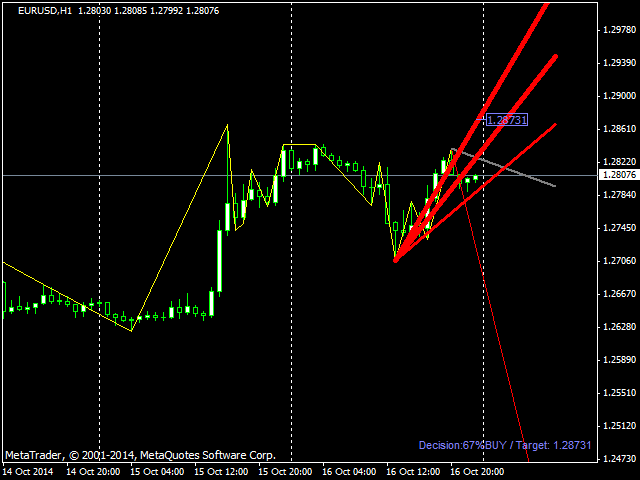This indicator is created as an extension and generalization of the M and W wave patterns of A. Merrill. With 5 extremes or 4 zigzag segments, it is easy to build an M or W shape anywhere in the quote history. In the classical approach, the various configurations of the zigzag waves are reduced to a predefined set of shapes that allow transformations according to special rules — and this allows you to predict the last segment of the zigzag. In contrast, this indicator analyzes the available history and builds statistics for all M and W figures that differ by no more than a specified number of percent along the length of the segments. With this information, you can predict the next segment of the zigzag on any M or W figure identified in the history. This process is repeated for 7 different zigzag ranges, and the forecast results are brought together in the form of an average target price and recommendations — buy, sell, or wait.
This indicator builds a zigzag using another HZZM indicator. The indicator is redrawn by bars (ticks are not processed).
The indicator displays a combination of 7 instances of different zigzags in yellow segments on the history (the result is not a zigzag!), and in the future — the expected segments of the next movements for each of the 7 zigzags. Future segments can be red or gray. Red color — a satisfactory forecast, gray color-little data for the wave configuration that occurred. Based on the forecasts of the red segments, the average price of the target and the signal level are calculated (the greater the number of final zigzag levels located on one side of the current price, the stronger the signal, and if the number of forecasts up and down is the same, it will be 0%). The target price is displayed using a label, and the signal strength is displayed in the corner of the chart.
[spoiler title=”Read More…”]
- HistoryDepth — the number of bars where statistics are collected; by default-5,000;
- ZigZagRange — most zigzag range (in points) that is passed to the HZZM indicator; the default is 0, which means the automatic detection of the total range of quotes and generation 7 suitable ranges for zigzags; if the numbers 1000 and more, it is used as the maximum range of 7, 6 and the rest are calculated from it by successive division by ~1.4 (sqrt(2));
- Deviation — the allowed percentage difference between the corresponding zigzag segments in different shapes, in which the shapes will be considered identical; default-33; minimum value — 10, maximum-50; recommended values— 10, 20, 25, 33, 50;
- Corner — the corner of the graph where to display the text with the solution; by default-3 (lower right); other values: 0-upper left; 1-upper right; 2-lower left;
- Offset — the number of bars to shift the processing to the left; this allows you to analyze the behavior of the indicator on the history; by default-0-prediction for the last bar;
- Original-the parameter passed “as is” to the HZZM indicator; it switches the mode of operation from the standard HZZ algorithm to the modified HZZM; for details, see the description of HZZM; by default, false.
The screenshots show how the indicator works with the default settings, with the exception of Screen 2, where Offset is 10, i.e. the bar marked with a vertical dashed line is the last known indicator, and everything to the right of it is a forecast.
[/spoiler]





